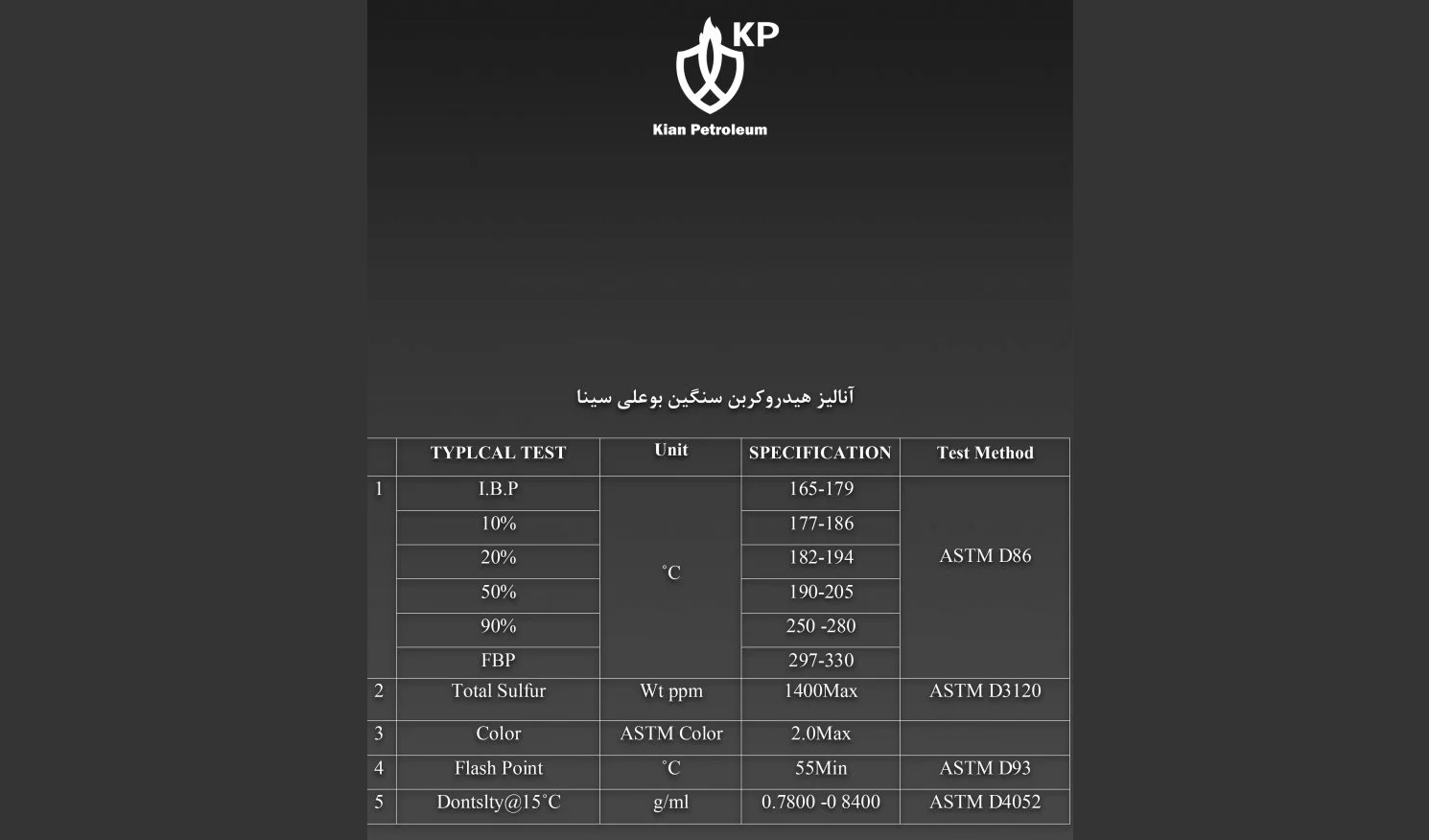تاریخ بروزرسانی(Update Date): 20th January 2025
Heavy Hydrocarbon Analysis

Heavy hydrocarbon analysis is essentially a specification sheet that examines the physical and chemical characteristics of the heavy hydrocarbon offered, through various tests.
Applications of Heavy Hydrocarbon Analysis
This analysis helps us understand the quality and appropriate applications of the hydrocarbon through its chemical and physical properties. Additionally, it reveals the processes that can be applied to it. For instance, if the sulfur content is high, this hydrocarbon is not suitable for the cracking process to produce lighter products like LPG gas. Overall, heavy hydrocarbon analysis enables producers of light and heavy hydrocarbons to produce higher-quality products.
Heavy Hydrocarbon Analysis Components
IBP (Initial Boiling Point)
The initial boiling point refers to the temperature at which the first drop of a petroleum fraction (in this case, heavy hydrocarbon) is formed during condensation. The initial boiling point is represented as a temperature range, which serves as a relative indicator of the quality of the petroleum fraction and the processes that should be applied to it.
FBP (Final Boiling Point)
The final boiling point also represents a temperature range, indicating the point at which the last drop of the petroleum fraction evaporates. Like the initial boiling point, this component provides important information about the quality, performance, and safety of the product.
Sulfur Content
The higher the sulfur content in heavy hydrocarbons, the lower the quality of the fuel or product obtained, leading to poorer performance and higher emissions. Therefore, high-sulfur hydrocarbons undergo a desulfurization process first. It is worth noting that refineries apply refining processes tailored to each product based on its sulfur content.
Color
In heavy hydrocarbon analysis, color refers to the visual characteristic of the sample, which can provide information on its purity, quality, and levels of contaminants. A lighter color typically indicates higher purity and lower contamination, while a darker color suggests the presence of heavier compounds, pollution, and higher levels of impurities in the sample.
Flash Point
The flash point is the temperature at which a material has produced enough vapor to ignite with a small spark or flame. The lower the flash point, the less safe the material is, as it ignites more easily at lower temperatures. This property plays a crucial role in determining safe storage and transportation conditions.
Density at 15°C
Density is a criterion used to assess the quality and classify fuels and petroleum products. Industry experts use density to calculate the amount of energy in a specific volume of fuel. The temperature of 15°C is a reference standard for comparing the density of different liquids, as temperature affects material density.
Purchasing Heavy Hydrocarbon from the Energy Exchange Export Ring
Due to the diverse applications of heavy hydrocarbons across various industries, these products are in high demand from customers. Heavy hydrocarbons play a vital role in the economy and industrial development, given their unique characteristics for producing chemicals, fuels, and other industrial products. Producers of light and heavy hydrocarbons offer their products on the Energy Exchange to meet market demands and deliver high-quality products.
Kian Petroleum proudly offers brokerage services for purchasing from the international ring of the Energy Exchange to its clients. These services include specialized market analysis consulting, facilitation of administrative procedures, and continuous support for customers. As a trusted intermediary, we strive to make the purchasing process straightforward and transparent for clients, assisting them in selecting the best options.
Heavy Hydrocarbon Sale Conditions
After submitting the required documents to the Energy Exchange, the buyer must deposit 10% of the total transaction value as a prepayment before the offering begins. This amount must be deposited into the central deposit account no later than one hour before the start of the trading session.
To calculate the prepayment exchange rate, the average buying and selling rate of dollar banknotes in the SANA system (affiliated with the Central Bank of Iran) is considered. This rate is used to determine the prepayment amount two business days prior to the offering.
However, for the exchange rate at the time of the transaction, the buying and selling rate of the dollar in the SANA system from one business day before the transaction is used, which is then applied to calculate fees and the value of the transaction.
After the transaction is fully completed and settled, the prepayment amount will be returned to the account designated by the buyer; however, this will occur after deducting the legal fees. The settlement of the transaction will be carried out through off-exchange documents in accordance with the rules of the clearinghouse and the guidelines of the Energy Exchange’s export ring. Additionally, the responsibility for the declaration and issuance of goods in the buyer’s name will rest with the buyer themselves.
In any case, each offering notice must be read carefully, as there may be slight differences among them. In this regard, we recommend contacting our advisors to obtain complete information about each offering notice and the analysis of the heavy hydrocarbon involved.

